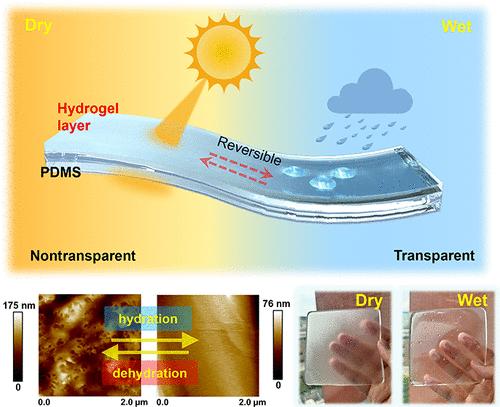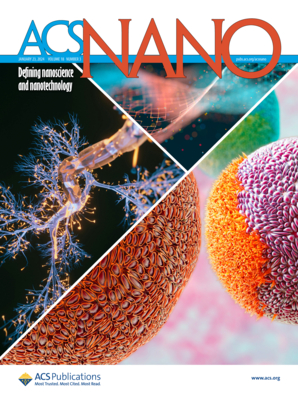Hydrogel-Coated Polydimethylsiloxane with Reversible Transparency for Advanced Optical Switching
IF 15.8
1区 材料科学
Q1 CHEMISTRY, MULTIDISCIPLINARY
引用次数: 0
Abstract
Functional soft materials that swell in water often exhibit surface wrinkling, similar to the ridges formed on human skin after prolonged immersion, typically leading to reduced optical transmittance. Surprisingly, there is a scarcity of materials that are transparent underwater yet opaque in air, despite their vast potential in applications such as smart windows, periscopes, and information encryption. Herein, we report a hydrogel-based system comprising a polyacrylamide layer on polydimethylsiloxane (PDMS), demonstrating a reversible transition between opacity in air and high transparency in water or wet conditions. Upon water-induced swelling, the transmittance of the hydrogel layer markedly increases from 7.8% in air to 77.1% with excellent repeatability. This behavior enables applications such as optical encryption and decryption and water writing. Micro- and nanostructural analysis reveals that the optical switching arises from the reduction in local surface roughness upon hydrogel swelling. Furthermore, when employed as a smart window, the hydrogel layer effectively reduces solar power transmission by 36%, achieving a temperature reduction of 5.09 °C under direct sunlight while retaining heat in the absence of sunlight. These findings highlight the hydrogel layer on PDMS as a versatile platform for water-responsive smart devices, offering exciting opportunities in optical encryption, interactive writing systems, and energy-efficient window technologies.

求助全文
约1分钟内获得全文
求助全文
来源期刊

ACS Nano
工程技术-材料科学:综合
CiteScore
26.00
自引率
4.10%
发文量
1627
审稿时长
1.7 months
期刊介绍:
ACS Nano, published monthly, serves as an international forum for comprehensive articles on nanoscience and nanotechnology research at the intersections of chemistry, biology, materials science, physics, and engineering. The journal fosters communication among scientists in these communities, facilitating collaboration, new research opportunities, and advancements through discoveries. ACS Nano covers synthesis, assembly, characterization, theory, and simulation of nanostructures, nanobiotechnology, nanofabrication, methods and tools for nanoscience and nanotechnology, and self- and directed-assembly. Alongside original research articles, it offers thorough reviews, perspectives on cutting-edge research, and discussions envisioning the future of nanoscience and nanotechnology.
 求助内容:
求助内容: 应助结果提醒方式:
应助结果提醒方式:


